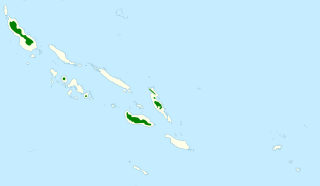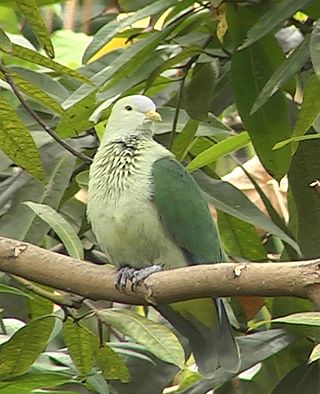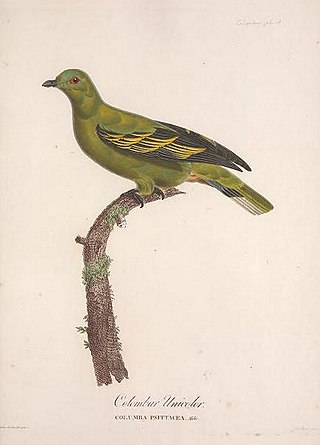
The jambu fruit dove is a smallish colourful fruit dove. It is a resident breeding species in southern Thailand, Malaysia, Brunei and the Indonesian islands of Kalimantan, Sumatra and Java.

Wallace's fruit dove is a species of a bird in the pigeon family Columbidae. The name commemorates the British naturalist Alfred Russel Wallace. It is a rather large, long-tailed fruit dove with a length of 24–28 cm (9.4–11.0 in) and has been described as "one of the most beautiful" fruit doves. The forehead and crown are dull crimson, the lower face and throat are white, and the rest of the head, breast, neck, and upper back are pale bluish-grey. The wings and lower back are green and the belly is orange, separated from the chest by a white band. Both sexes look similar, but females have less extensive red on the head and a greenish tinge to their grey parts.

The rose-crowned fruit dove, also known as pink-capped fruit dove or Swainson's fruit dove, is a medium-sized fruit dove that is found in parts of southern Indonesia, northern Australia and eastern Australia.

The blue pigeons are a genus, Alectroenas, of birds in the dove and pigeon family Columbidae. They are native to islands in the western Indian Ocean.

The black imperial pigeon, also known as the Bismarck imperial pigeon, is a species of bird in the pigeon family, Columbidae. First described by English zoologist Philip Sclater in 1878, it is endemic to the Bismarck Archipelago, where it mainly inhabits rainforest and cloud forest in mountain areas above 500 m (1,600 ft). It is a large, heavily-built imperial pigeon, with a length of 38–43 cm (15–17 in) and a weight of 661–665 g (23.3–23.5 oz). Adults are almost entirely black, except for the dark chestnut undertail coverts, the silvery-grey underside of the tail, and a pale grey scaly pattern on the wings and back. Both sexes look alike. Juveniles differ from adults in having paler undertail coverts.

The Palau ground dove is a species of bird in the family Columbidae. It is endemic to Palau, living in forests. The IUCN has assessed it as an endangered species.
The Wetar ground dove is a species of bird in the family Columbidae found on Wetar, Indonesia, and on Timor. Its natural habitats are monsoon forests and gallery forests, and possibly woodland and bamboos. Threatened by habitat loss and hunting, the species is assessed as endangered by the IUCN.

The pale mountain pigeon is a species of bird in the pigeon family Columbidae. It is endemic to the Solomon Islands archipelago, where it inhabits old-growth and secondary montane forest. It is a medium-size pigeon with an average length of 38 cm (15 in) and a weight of 310–385 g (10.9–13.6 oz). The head and neck are whitish-grey, the belly and lower breast are buffy-pink, and the vent and undertail coverts are pale grey. The upperparts are smoky-grey with darker fringes on the mantle and wing coverts. Both sexes look similar, but there can be large variation in individual appearance.
The Timor cuckoo-dove is a species of bird in the family Columbidae. It is found in Timor, Wetar and the eastern Lesser Sundas. It was previously lumped together with the Tanimbar cuckoo-dove and the Flores Sea cuckoo-dove as the dusky or bar-necked cuckoo-dove. It is rated as a species of least concern on the International Union for Conservation of Nature Red List of Endangered Species.
The bar-tailed cuckoo-dove or black-billed cuckoo-dove is a species of bird in the family Columbidae. It is native to New Guinea and the Bismarck Archipelago. It is rated as a species of least concern on the International Union for Conservation of Nature Red List of Endangered Species.

The Negros fruit dove is a species of bird in the pigeon and dove family, Columbidae. It is endemic to the island of Negros in the Philippines. This fruit dove is known from a single female specimen collected from the slopes of Mount Kanlaon in the northern part of the island. While it was found at a high elevation, it is suspected that the species originally lived in the lowland dipterocarp forests and was driven to higher elevations by habitat destruction. While some have suggested that the specimen is either a runt or a hybrid instead of a valid species, this is not widely accepted. The female Negros fruit dove was a small fruit dove with vivid dark green plumage and an ashy-grey forehead. It had a distinctive ring of bare yellow skin around its eye, and yellow fringes to some of its feathers gave it the appearance of having a yellow wingbar when perched. The throat was white, while the undertail and vent were yellow.

The cream-breasted fruit dove or cream-bellied fruit dove is a species of bird in the family Columbidae. It is endemic to the Luzon region of the Philippines.Its natural habitat is subtropical or tropical moist lowland to montane forests of up to 1,300 masl. It is threatened by habitat loss, and trapping for the pet trade.

The yellow-breasted fruit dove locally known as balorinay is a species of bird in the family Columbidae. It is endemic to the Philippines. Its natural habitat is tropical moist lowland forest. While it is listed as least concern in IUCN, it is declining due to habitat loss, hunting, and trapping for the illegal wildlife trade.

The grey-green fruit dove is a species of bird in the family Columbidae. It is endemic to the Society Islands in French Polynesia. Its natural habitat is subtropical or tropical moist lowland forests.

The pied cuckoo-dove is a species of bird in the pigeon family, Columbidae. First described by English zoologist Philip Sclater in 1877, it is endemic to the Bismarck Archipelago, where it mainly inhabits lowland and hill forests at elevations of up to 1,000 m (3,300 ft). It is a large, distinctive pigeon, with a length of 40–46 cm (16–18 in) and a weight of 279–325 g (9.8–11.5 oz). Adults are mainly black and white. The heads and underparts are whitish, while the wings, tails, and upperparts are black. Both sexes look alike. Juveniles are mainly sooty-grey in colour.

The crested cuckoo-dove is a species of bird in the pigeon family, Columbidae. First described by English zoologist John Gould in 1856, it is endemic to the Solomon Islands archipelago, where it mainly inhabits hill forests at elevations of 500–900 m (1,600–3,000 ft). It is a large and robust pigeon, with a length of 40–42 cm (16–17 in) and a distinctive pale purplish-grey crest. Adults are mainly bluish-grey, with a pale greyish-buff throat, blackish tail, and yellow-tipped reddish bill. Both sexes look alike. Juveniles lack the crest, have darker heads, and have duller wings.

The Timor green pigeon is a species of bird in the family Columbidae. It is found on the islands of Rote and Timor. Its natural habitat is subtropical or tropical moist lowland forests. It is threatened by habitat loss.

The thick-billed ground pigeon, also known as the jungle pigeon or the slaty/grey ground pigeon, is a species of bird in the family Columbidae. It is monotypic within the genus Trugon. Native to New Guinea, its natural habitat is moist tropical lowland forest.

The fruit doves, also known as fruit pigeons, are a genus (Ptilinopus) of birds in the pigeon and dove family (Columbidae). These colourful, frugivorous doves are found in forests and woodlands in Southeast Asia and Oceania. It is a large genus with over 50 species, some threatened or already extinct.



















